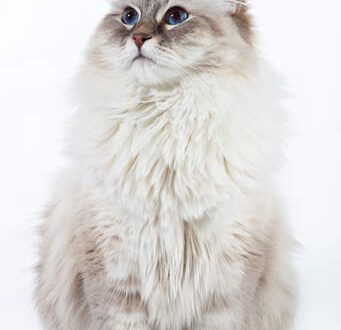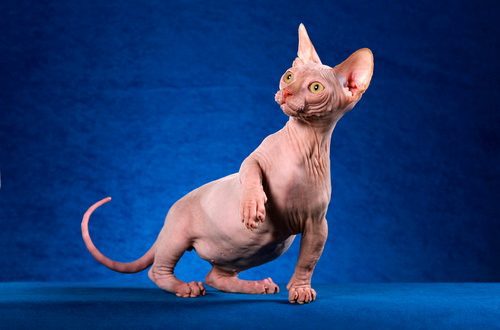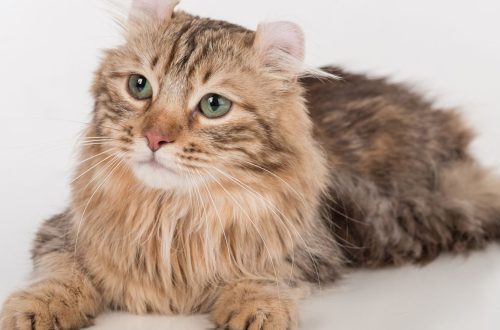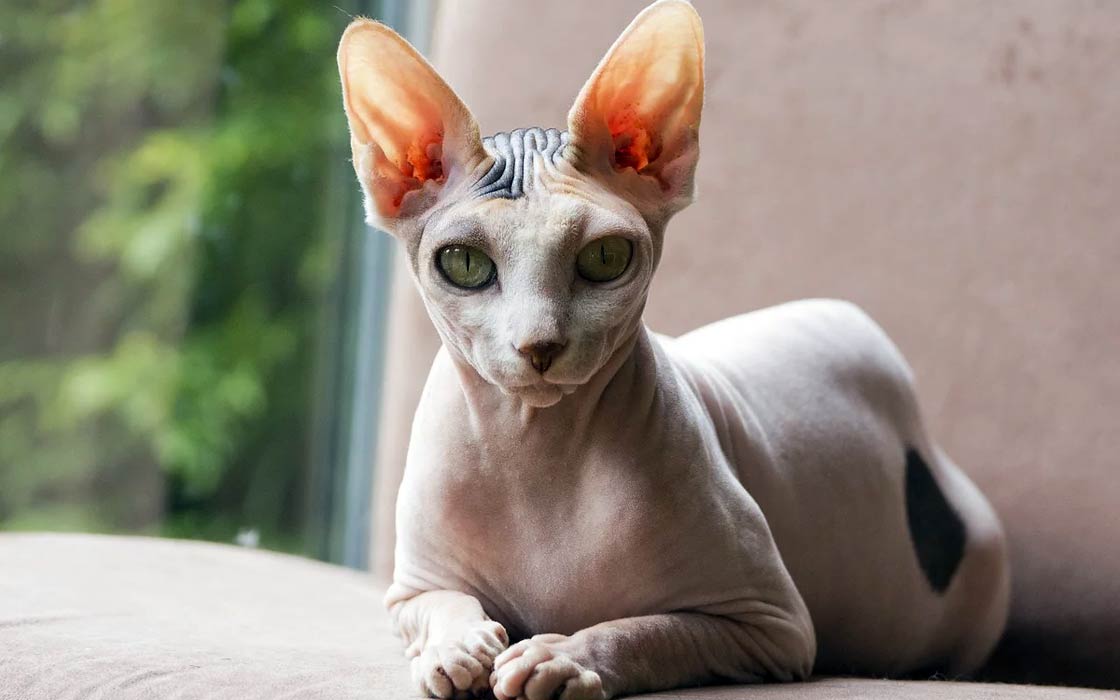
Peterbald or Petersburg Sphinx
Other names: St. Petersburg Sphynx
Peterbald is a hairless breed of graceful and elegant cats originally from St. Petersburg. Thanks to their friendly and accommodating nature, Peterbalds have won universal love and respect.
Contents
- Characteristics of Peterbald or Petersburg Sphinx
- Basic moments
- History of the peterbald cat breed
- Video: Peterbald
- The appearance of the Peterbald and its differences from the Don Sphynx
- Peterbald character
- Education and training
- Peterbald Maintenance and care
- Health and disease of Peterbalds
- How to choose a kitten
- The price of the St. Petersburg Sphinx
Characteristics of Peterbald or Petersburg Sphinx
| Country of origin | Russia |
| Wool type | bald, short haired |
| Height | 23–30 cm |
| Weight | 3–5 kg |
| Age | 13–15 years old |
Basic moments
- The name of the breed “Peterbald” can be translated into Russian as “bald Peter”. However, fans of eared cats prefer to call their pets simply “petriks”.
- Petersburg sphinxes are born kinesthetics, preferring tactile contact to mental connection.
- The skin of completely bald Peterbalds produces a large amount of secretion, therefore, it requires careful and at the same time gentle care.
- Representatives of the hairless variety of the breed are called “gammi” or “rubber bands” for their elastic, slightly sticky skin.
- Peterbald is hot in the truest sense of the word. The body temperature of these charismatic hairless cats is much higher than that of ordinary “wool” cats, so they can be used as heating pads on occasion.
- This is one of the most talkative varieties of sphinxes with a rather demanding voice. What’s more, most cats don’t turn off their internal purr even when they sleep.
- Despite a small amount of coat, and often its complete absence, the breed is not hypoallergenic. To be more precise, the Fel D1 protein in the saliva of the “Petersburgers” is present in the same volume as in cats with full-fledged hair.
- Peterbalds, like all bald purrs, have accelerated thermoregulation. Hence – a brutal appetite that does not fit in with the model appearance of the pet.
- Cats from the banks of the Neva are very jumpy, but at the same time extremely graceful, so you usually don’t have to worry about the safety of porcelain figurines and flower pots.
- The breed loves warmth, but direct ultraviolet rays are not very useful for it, and even harmful for naked Peterbalds.
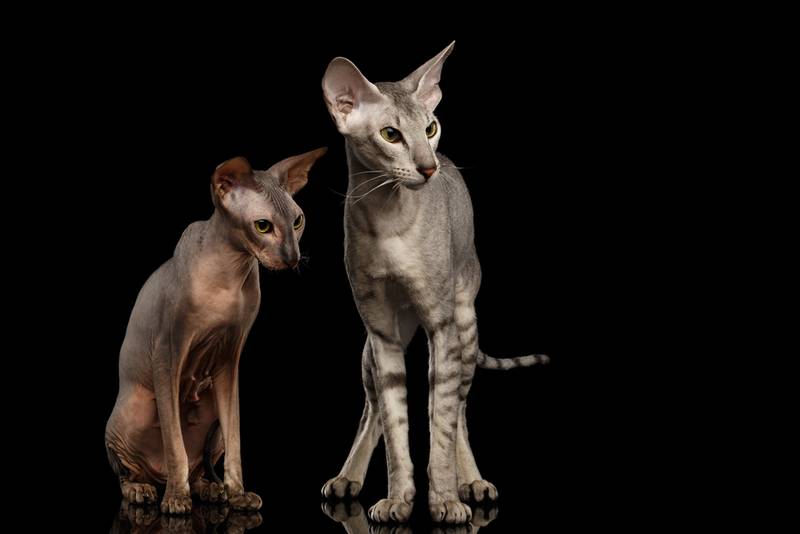
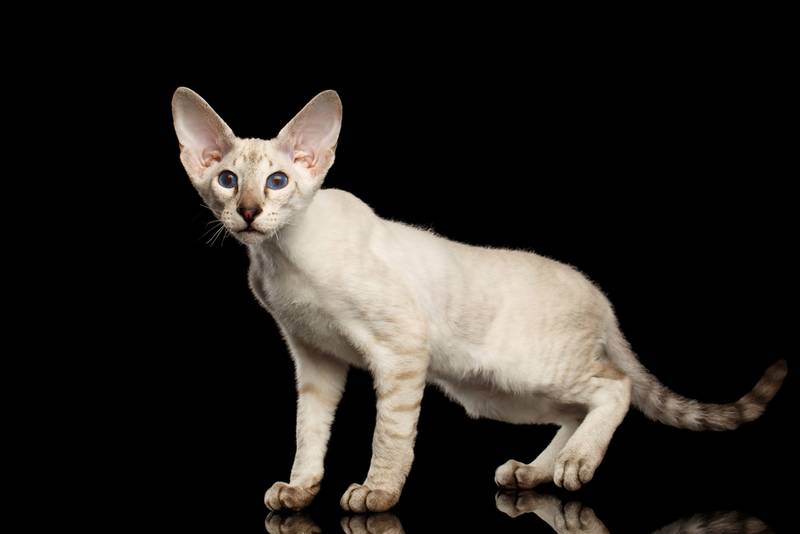
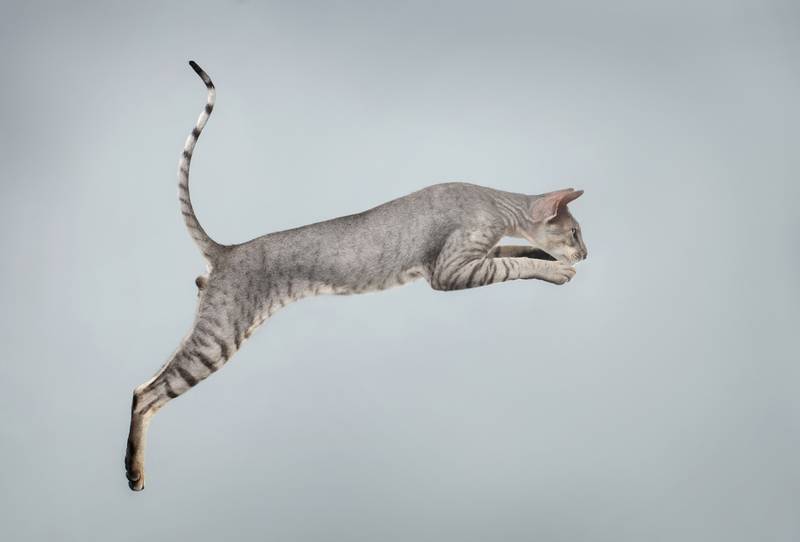
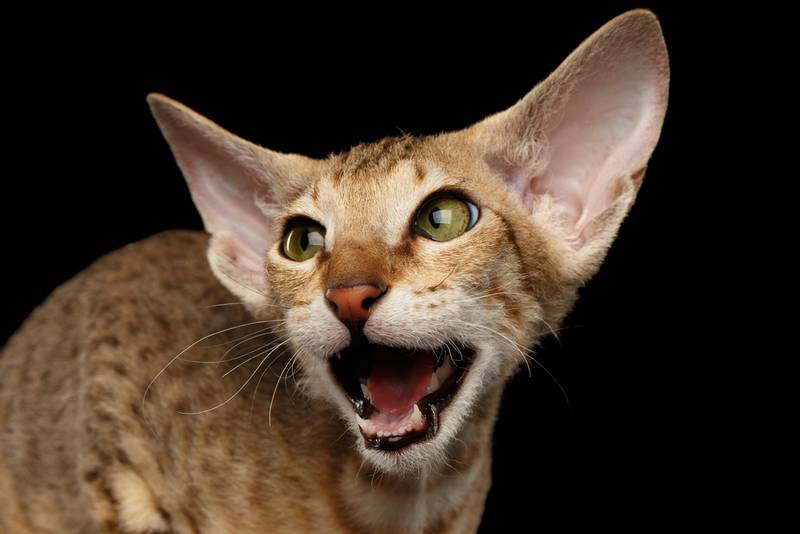
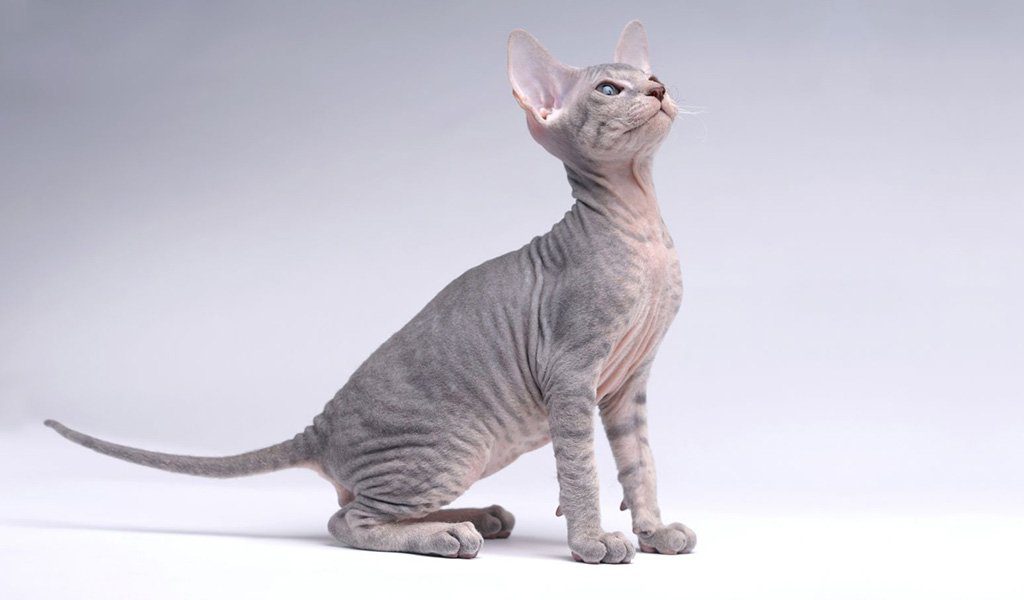
Peterbald is a talking cat, a sophisticated top model with a dreamy look and bat ears, who cannot live a day without hugs and heart-to-heart conversations with her owner. Among inveterate cat lovers, “Petersburgers” are known as a privileged caste, the purchase of a representative of which is regarded as a transition to a new, higher level. As for the shortcomings, the breed has only one: having once acquired a St. Petersburg Sphynx, it is almost impossible to control oneself so as not to start buying up animals by families. Very extraordinary and sociable pets are obtained from these purrs. Distinctive features of the Peterbald: a completely or partially hairless body, a graceful snake-like profile, an elegant figure with a strong bias towards the Siamese-oriental type.
History of the peterbald cat breed
Peterbald is a 100% breeding “product” obtained by crossing the Oriental and the Don Sphynx . The first experiment to create a new breed branch was carried out in 1994 by Olga Mironova, a St. Petersburg felinologist. As a result of planned outcrossing, four hybrid kittens were born: Nezhenka from Murino, Nocturne from Murino, Mandarin from Murino and Muscat from Murino. It was these cats that were listed in the studbooks as the official ancestors of today’s Peterbalds.
Recognition of felinological associations “Petriki” received relatively quickly. In 1996, the SFF gave the go-ahead for breeding the St. Petersburg Sphynx, and a year later TICA joined it, approving the abbreviation PD for the breed. In 2003, the animals were recognized by the WCF, assigning their own abbreviation – PBD. It is worth making a small clarification here: despite the successfully completed standardization and official breed status, the Peterbald branch remains developing, which means that breeders are only planning to obtain its reference representative. Nevertheless, since 1997, mating between the Don Sphynx and the “Petersburgers” is officially prohibited.
Both earlier and now, breeding specialists do not set as their goal the breeding of exclusively hairless cats, they are more concerned about the extremization of their external characteristics. So, the ideal Peterbald in the understanding of felinologists should be close to the oriental type of appearance, that is, combine the maximum of Siamese and Oriental breed traits . Moreover, the amount of wool on the body of an animal practically does not affect its value, both in breeding and financial terms. An exception is the flat-haired variety of the breed, but more on that later.
Video: Peterbald
The appearance of the Peterbald and its differences from the Don Sphynx
Judging by images from the Internet, cats from the city on the Neva are not much different from the Don Sphynxes. However, in real life, Peterbalds are much smaller and more refined than their southern counterparts. In particular, the weight of the average “bald Petit” fluctuates within 3-5 kg, while the “Donetsk residents” can increase their weight up to 7 kg.
Among other things, the “Petersburgers” are characterized by outstanding grace, bringing them closer to the Orientals , and less “folding” of the skin. If the Peterbald inherited a rough skeleton and puffy forms of the “donchak”, this can be considered as a serious exterior defect. Present in each of the breeds and their own characteristics in the structure of the skull. For example, the head of the Don Sphynx has an exotic, almost alien outline, while the faces of Peterbalds are associated with flat snake heads.
Head
Peterbalds have a wedge-shaped skull that widens from the nose towards the ears. The muzzle of the cat is long, with a slightly convex profile and a flattened forehead.
Peterbald Ears
The ear flap is large, wide at the base, continuing the wedge of the cat’s muzzle.
Eyes
The eyes of the St. Petersburg Sphynx are almond-shaped, set obliquely. The traditional color of the iris is green, but bright blue eyes are acceptable for individuals with a point suit.
Frame
The body of the Peterbald is elongated, muscular, with an elegant silhouette line. The neck is graceful, elongated. The chest is somewhat narrower than the hips.
limbs
The legs of Peterbald cats are long, thin and perfectly straight. The paws of the animal are in the form of an oval, with flexible, so-called “monkey” fingers.
Peterbald Tail
Long, whip-like, thin along the entire length, with a pointed tip.
Vibrissae
The standard cat whiskers of the St. Petersburg Sphynxes are either absent as such, or have a shortened broken-curved design.
Skin and coat
In a correct Peterbald, the skin should be soft, loosely fitting the body, forming numerous folds on the head and a slightly smaller number of them on the body. By inheritance from the Don Sphynx, the breed received a hairless gene, so the classic Peterbald is, in fact, a hairless cat, in some cases having a rare and short coat.
Varieties of St. Petersburg sphinxes
- Hairless (“gummy”, “gum cat”) – animals with a complete absence of hair. To the touch, the skin of such cats resembles thin rubber. Another feature of hairless Peterbalds is intense skin secretions that form a thin layer of brownish plaque on the body.
- Flock – beardless and eyebrowless individuals with ultra-short silky hair (up to 2 mm) along the body.
- Velor – kittens with short or semi-long hair, which, as they grow older, can disappear, leaving small shaggy “islands” on their paws (socks, golfs). In general, the wool of velor petriks is thicker than that of flocks.
- Brush-pointed – individuals with a naked or delicately flocked body and thick, hard hair on the muzzle, paws and tail.
- Brushed – pets with hard / soft crimped hair, fully or partially pubescent. As a brushed cat grows older, it may become bald in the neck and back, but it does not shed its hair completely.
Separately, it is worth mentioning the flat-haired variety of Peterbalds or flat-haired. These are animals that have not inherited the hairless gene, have classic cat coats and normal straight mustaches. Such individuals are not plembars, and in exceptional cases they can even be recommended for breeding, but they are much cheaper. By the way, in terms of physique, it is the flat-haired varietta that is closest to its ancestor – the oriental .
An important point: in addition to the types listed, the St. Petersburg Sphynx has several intermediate coat options like flock point, velor point and others, which, as the animal grows older, can move into other varieties. This feature greatly complicates the choice of a kitten, since it is almost impossible to predict how a pet will look like in adulthood.
colors
St. Petersburg Sphynxes are characterized by color-point and oriental types of colors. In the first case, cats can have colors: tabby, tortie, blue, lilac, chocolate, seal, red and cream point. Oriental Peterbalds are blue, black, cream, chocolate, red, tabby, bicolor and tortoiseshell.
Disadvantages and vices of the breed
- Extremely lightweight frame.
- Curved front paws.
- Absence of skin folds on the head.
Peterbald character
The St. Petersburg Sphynx is an open and contact breed (often beyond measure). These hairless ears do not accumulate negativity, preferring to occupy their own memory only with positive impressions, they are always frank in expressing feelings and are not prone to traditional feline intrigues. The only thing that can annoy a Peterbald is the strategic supply of affection that he needs to splash out on a person. So it’s better not to acquire “Neva Sphynxes” for hardened introverts who need personal space.
A fairly common mistake is trying to mistake the good nature and sociability of Peterbalds for spinelessness. Keep in mind that by the type of temperament, bald cats are more likely to be choleric than melancholic. Yes, their favorite pastimes are eating all sorts of delicacies and lying on something soft and warm, but with the wrong upbringing and lack of attention, they can turn into real tear-offs. So if you stumbled upon a review about the evil “Petersburger” on the net, in 9 cases out of 10 it is a story of inexperienced lazy owners who took the animal as an interior decoration and did not even try to establish relations with it. By the way, for all their canine affection for the owner, Peterbalds are not monogamous and in the event of a spontaneous move to a new family, they will easily establish contact with its members. For this breed, it is not so important who to love. The main thing,
Otherwise, the Peterbald is a cat without pretensions: patient, accommodating, understanding. If you are tired of independent pets slashing your child’s hands with or without reason, take the St. Petersburg Sphynx into your upbringing and make sure that not all cats are in conflict with the kids. With other representatives of the domestic fauna, cats also have peace and mutual understanding. Especially “Petersburgers” are not indifferent to their bald brothers. So, having settled a couple of representatives of this breed in the house, get ready to watch the tenderness and caresses that animals will bestow on each other without any measure.
The natural curiosity of Peterbalds” is something beyond description. A closed door, a lady’s purse fastened with a zipper, a cardboard box brought by a courier – all this is an irresistible temptation for the monkey fingers of the St. Petersburg Sphynx. It is better not to introduce the pet into temptation and do not try to hide anything from him. A Peterbald won’t be a Peterbald if he doesn’t declassify what caught his attention.
Education and training
In order to educate a “Petersburger” and develop in him the ability to respond not to the standard kitty kitty, but to his own nickname, it is not at all necessary to have the talent of Yuri Kuklachev. This breed is willing and easy to learn, especially if you present classes in a playful way. As for the reaction to prohibitions and other requirements, the Peterbald quickly recognizes commands such as “No!” and “To me!”. With sufficient perseverance, a cat can even be trained to fetch small objects. True, moving on to training, it is worth considering the desire of the trainee himself. Peterbalds are mood cats and if they don’t want to, they won’t work for any treats.
You should start raising a kitten with its socialization. In fact, the St. Petersburg Sphynx is a brave breed, but it will still have to be taught to harsh sounds and noise of household appliances. Do not walk around the baby on tiptoe, but often turn on the vacuum cleaner, hair dryer and other household gadgets in his presence – let him get used to it. If you are an avid traveler and dream of instilling a passion for travel and a pet, then the Peterbald is ideal in this regard. True, provided that you started organizing the first joint tours when the baby was a couple of months old.
The breed has no problems with the toilet. Moreover, Peterbalds are so quick-witted that they are able to master the use of the toilet, and no special tricks are required to form the skill. It is enough to change the usual tray to an accustoming pad, and then gradually raise it (at first, stacks of old newspapers will come in handy) until the structure is level with the toilet bowl. The next step is to move the lining on the toilet seat. Do not make a sharp transition, but smoothly, a couple of centimeters, move the cat litter to the toilet seat. The animal must get used to doing its business without fear. The final level is the rejection of the lining and the provision of a regular toilet for the cat.
Peterbald Maintenance and care
Since the St. Petersburg sphinxes are more than modestly dressed, they do not like cold and drafts. Accordingly, care must be taken that the temperature in the house is comfortable for the pet, that is, not lower than +23 ° C. Be sure to provide the animal not with a classic bed, but with a closed house with soft bedding, installed above the floor level. But do not be surprised if the pet will rest in it once a week. Usually Peterbalds prefer to doze next to the owner, striving to find a warmer place, or even to get under the covers.
It is possible and necessary to bring a cat out into the street: St. Petersburg sphinxes should not grow in greenhouse conditions. Just watch the temperature. For example, in the sun, “rubber” Peterbalds quickly burn, which is why their skin becomes dry, rough and brightly pigmented. At the same time, short ultraviolet baths are useful for animals: with the right dosage, a light tan gives the pet’s skin a more saturated and interesting shade.
In cool weather, petriki are very cold, so breeders recommend wrapping a cat in clothes already at +22 ° C. True, you will have to take into account an important point: any clothes for the Sphynx are invariable scuffs on the skin. For a pet, this nuance does not play a role, but at the exhibition for an imperfect skin, the rating is reduced. So before the competitive program, it is better for Peterbald to run naked for a week (naturally, within the apartment). If you can’t do without cat vests and overalls, look for knitted wardrobe items or suits with seams outward. They don’t irritate the skin.
Hygiene
The complexity of caring for the breed directly depends on the amount of wool in its representatives. Flat-haired and brushed Peterbalds are less demanding in this regard than, for example, hairless individuals. In particular, for the “gummy sphinx” is characterized by intense secretions from the sebaceous glands. Outwardly, it looks like the cat is covered with a wax coating that slightly sticks to the fingers. However, this is not a reason to take your pet to the bathroom every day, since the secret performs a protective function and protects the skin from negative external influences and minor injuries. Of course, bathing a bald Peterbald is worth more often than the average cat, but you should not be too zealous. Washing off the protective lubricant, shampoos and other cat cosmetics dry the skin and often provoke its peeling. If the “Petersburger” looks too murky, you can make an alternative cleaning: moisten a clean rag with baby care oil and walk over the cat’s skin. And of course, take a responsible approach to the choice of cosmetic products, giving preference to Ph-neutral shampoos, and in the most severe cases, tar soap.
For your information: unevenly growing hair on the body of the velor Peterbald causes a strong desire to depilate the animal in order to enhance the external aesthetics. Resist the temptation and leave things as they are, because instead of ennobling the feline appearance, shaving will only worsen the structure of the coat.
Peterbald ears secrete an increased amount of secretion, but you need to take it calmly, that is, do not try to stick cotton swabs into the ear canal every day, but calmly clean the ear funnel once a week with a regular lotion from a veterinary pharmacy. The same procedure must be done with the fingers of the animal, since fatty deposits accumulate in the area between the claws and skin, which prevents the cat from moving. The tail of the Peterbald is an area of special attention. There are a lot of sebaceous glands at its base, therefore blockage of pores and pimples often occur in this area. Tail eels should be fought with cleaning veterinary lotions and wipes, so that later you do not have to contact a specialist to remove overgrown subcutaneous wen.
Be sure to set aside time for a daily eye examination of the Peterbald, because due to the lack of eyelashes, the breed “cries” more often than others. Naked “Petersburgers” are especially tearful, in which a thick jelly-like liquid accumulates in the corners of the eyelids. In the morning, look into the cat’s eyes and if there is mucus in them, remove it with a clean napkin or cloth. If the “jelly” in the corners of the eyelids has changed its transparency to brown and greenish hues, it is better to consult a specialist. And, please, no pharmacy drops without consulting a veterinarian, otherwise you risk leaving the ward without sight.
Peterbald claws can be cut a couple of times a month, which, of course, does not exempt you from buying a scratching post. It is advisable to additionally process the claw with a nail file so that when scratching, the St. Petersburg Sphynx scratches its own skin less.
Peterbald Feeding
Peterbald has a passionate lifelong romance with food, therefore, despite the almost ballet complexion, cats eat a lot, not embarrassed to beg for an extraordinary tidbit. Before the kitten is one year old, you can turn a blind eye to such behavior and not limit the baby in the diet. After all, it is a growing organism that needs more energy than an adult.
After a year, the food habits of “Petrikov” can and should be adjusted. Peterbald should not overeat, so as not to turn into a clumsy likeness of his relative – the Don Sphynx . At the same time, the animal itself categorically does not accept such an alignment and constantly strives to pull off something. If a cat from the cultural capital suddenly wants something delicious, he will definitely check all the pots and pans, inspect the contents of kitchen cabinets and without fail taste everything that you left on the table. Chocolate, canned vegetables, chips – Peterbald will not disdain anything, albeit to the detriment of his own digestion. So, having acquired a St. Petersburg Sphynx, from the first days wean yourself from the habit of leaving something edible in the public domain. And you are calmer, and the pet is healthier.
Peterbalds can be fed either by “drying” (dry croquettes are soaked in warm water for kittens), or by natural products. Some breeders practice mixed feeding (lean meat + industrial feed), despite the fact that most veterinarians criticize the method as harmful. As for the natural menu, it is the same for Peterbalds as for other breeds. The only difference is that cats are given heat-treated fish and as rarely as possible. Otherwise, nutritional recommendations and restrictions for St. Petersburg cats are standard: more lean meat protein and a little less variety of additives in the form of cereals, vegetables and fruits.
Health and disease of Peterbalds
No terrible hereditary diseases have been identified in St. Petersburg Sphynxes, however, the breed is actively developing, and it is not a fact that in the foreseeable future breeders will not announce an incurable genetic defect passing from parents to kittens. Some breeders tend to believe that Peterbalds do have a predisposition to lung infections. Experts argue their assumptions by the fact that cats with rhinotracheitis usually do not stop there, catching pneumonia after them.
Such physiological defects as underdevelopment of the thymus and hyperplasia of the gums (more often in animals of cream, blue and tortoiseshell colors) are also genetically determined. Otherwise, Peterbalds suffer from standard cat ailments such as seasonal colds, which bald individuals are primarily susceptible to, skin diseases (bald again) and eye problems. A change in the quality of fatty lubrication is an additional indicator that not everything is going smoothly in the animal’s body. If the secret is released too abundantly and has an excessively oily consistency, it is worth reviewing the cat’s menu together with the veterinarian.
How to choose a kitten
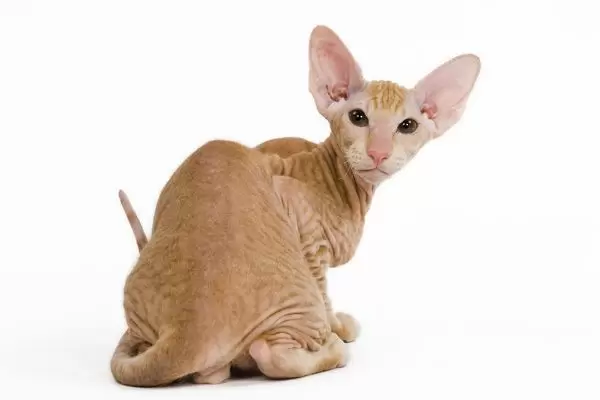
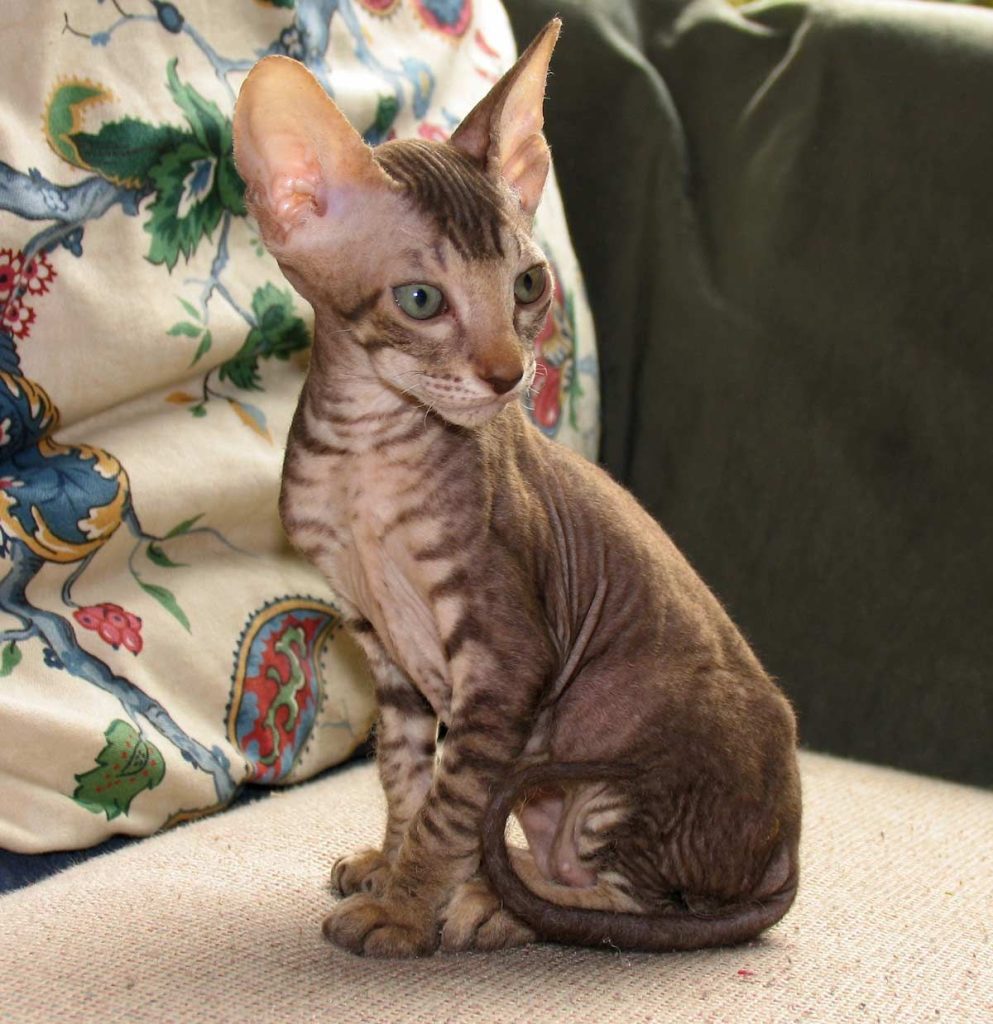
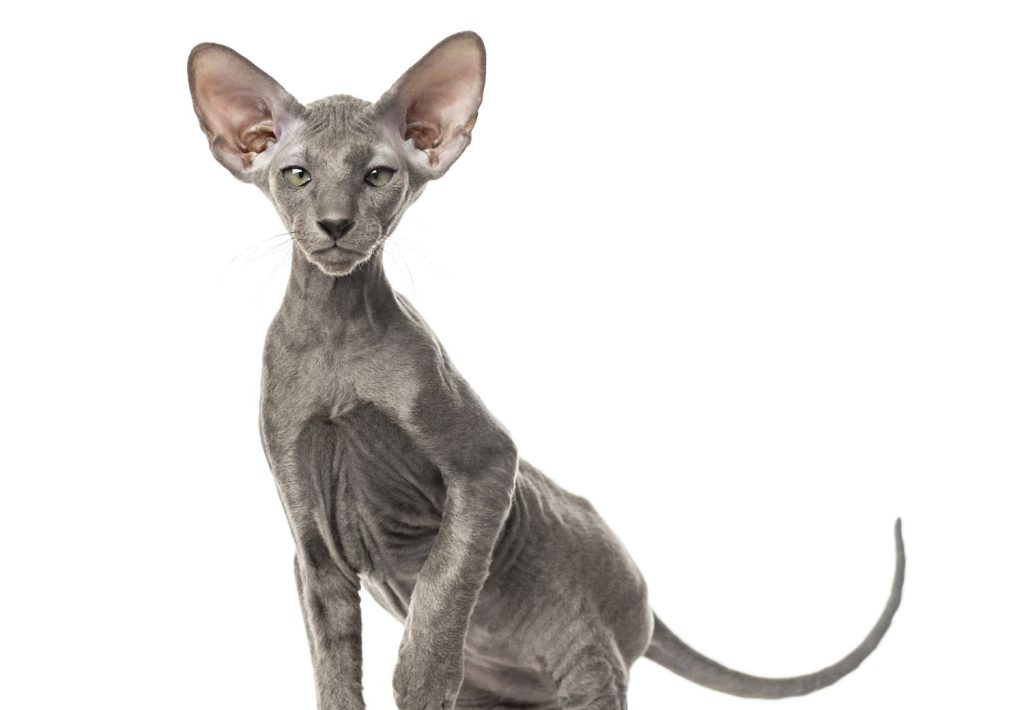
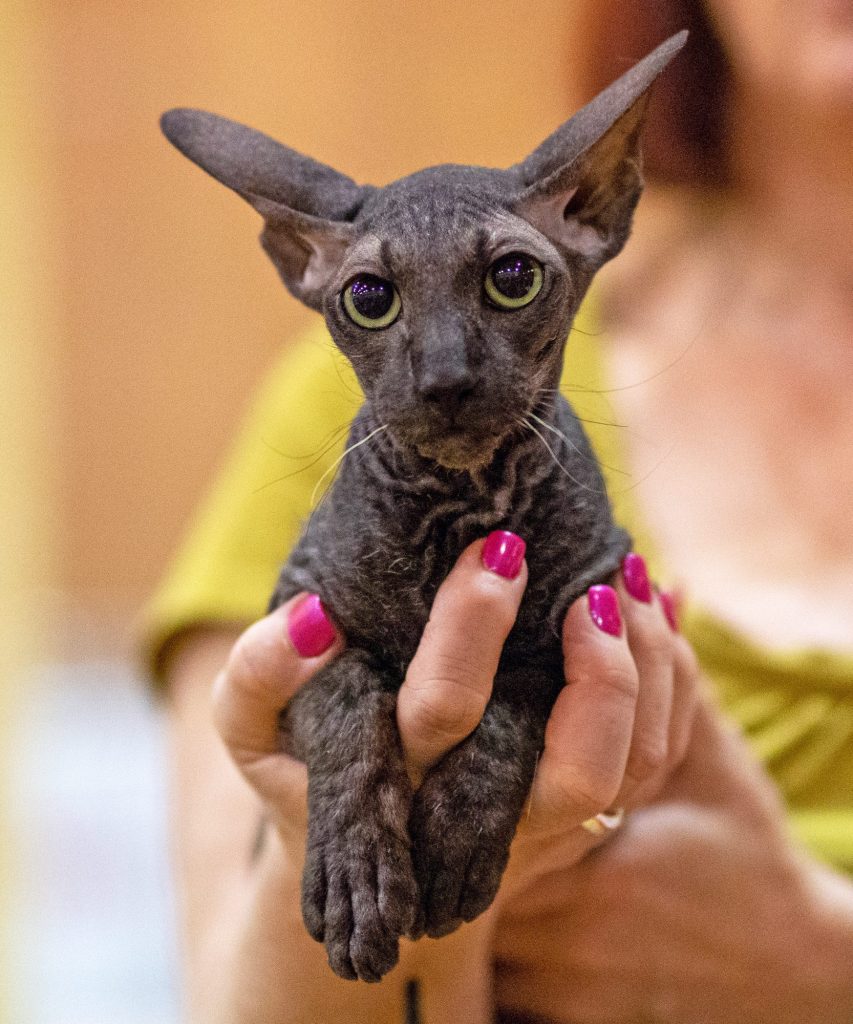
- Before buying a kitten, get to know the St. Petersburg Sphynx breed better, paying special attention to bald cats. If sticky, secreted skin and the characteristic smell emanating from the “gum” do not bother you, look for a reliable nursery.
- Commercial breeders often tailor their wards to the needs of buyers. In particular, instead of a bald Peterbald, you can buy a shaved flock or a representative of any other variety from such sellers. Please make sure you are dealing with a professional or registered cattery before purchasing.
- Color-pointed sphinxes are born completely white, and the color on the tip of the nose, tail, ears and paws appears a few days after birth.
- In one litter, completely naked, flocked and brushed kittens can be born, however, animals acquire stable external features only by the age of two. As a result: when buying, you should be prepared for the fact that instead of a flock pet, a flock or velor point cat will come across.
- Carefully inspect the kitten when he sits. If the keel protrudes too much in the St. Petersburg Sphynx, this is most likely a consequence of subluxation of the sternum, which is regarded as a defect.
- Gently feel the tail of your favorite Peterbald. It should be even, without creases, skin folds, knots and an empty leather pouch at the tip.
- The skin of a healthy Peterbald kitten should not show signs of eczema or pimples, although small scratches caused by the claws of littermates are acceptable.
- Breeders often offer brush and velor peterbalds as pets, saving “gummy cats” for exhibitions. However, here too much depends on the anatomy. If the orientation of the features is more visible in the brush / flock, the judging panel will rather award the victory to him than to the “naked” with flaws.
- When purchasing a naked born Peterbald for further breeding, be especially careful. Sometimes the “boys” of this variety are sterile, and the “girls” may not be lactating.
The price of the St. Petersburg Sphinx
Peterbalds are among the twenty most expensive cats in the world, so an exemplary representative of the breed with an elite pedigree and a rare suit will cost about 900 – 1600$. Options with less exotic colors, as well as animals without the right to breed, are much cheaper – 400 – 600$. The most economical option is a straight-haired varietta – from only 150 – 200$.



